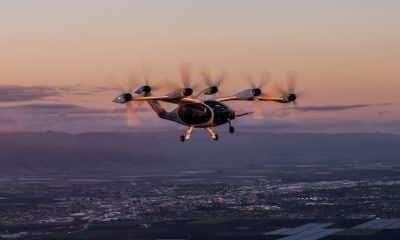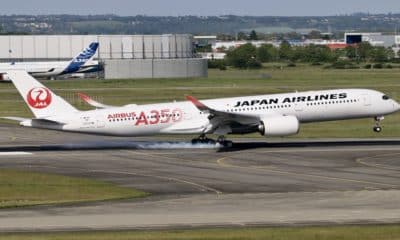Aviation
ANA Announces New Online Content “IS JAPAN COOL? DOU

Tokyo, August 23, 2017 – Today, All Nippon Airlines (ANA), Japan’s largest and only 5-Star airline, is proud to announce the launch of its new online content “IS JAPAN COOL? DOU”, which illustrates traditional Japanese culture through the use of cutting-edge technology. This content can be seen on “IS JAPAN COOL?,” a website that promotes tourist destinations and popular Japanese cultures to the world.
IS JAPAN COOL? DOU
https://www.ana-cooljapan.com/contents/dou/
While Japan is widely known for its unique pop culture, “IS JAPAN COOL?,” which launched in 2012, has put much of its focus on promoting Japan’s modern culture. As the number of tourists visiting Japan exceeded 24 million people as of 2016, the project aims to provide a deeper understanding and a new perspective on the true nature of Japan by introducing “the way of life,” hereby referred to as “DOU,” a cultural asset that is valued greatly in traditional Japanese culture.

DOU is composed of “budo (Japanese traditional martial arts)” and “geido.” “IS JAPAN COOL? DOU” introduces nine forms of Japanese art along with masters from each art.
Content highlights include:
l Introduction movie
Thunderous beating of the taiko joined by spiritual sounds of the bells, evoke an image of ancient times in Japan. Live action visuals of DOU masters are connected seamlessly with the latest digital technology, creating a modern, yet classical Japanese image, luring viewers into the world of “IS JAPAN COOL? DOU.”
l 4DViews*
Realistic holograms of each master performing key techniques and manners significant to each DOU, which can be seen from all 360 angles. Viewers can catch a glimpse of “the close-up of traditional Japanese culture” from anywhere around the world.
* 4DViews technology is a dynamic volumetric capture system, created in France in 2007, capable of filming live action actors in a large capture area, and then generating realistic holograms for virtual environments.
l Interview movie:
An interview with the nine masters, each narrating their own view of 1) fascinating facts about each form of art; 2) the necessary mindset when performing; and 3) the relationship each has with other countries. Live action versions of the masters’ performances can also be seen in the film.
DOU is an intangible form of cultural asset which has been passed down for generations through masters of the field. Re-creating the masters’ movements with technology in a tangible form will contribute to spreading the traditional Japanese culture and furthermore, the values of “the way of life” to the world. “IS JAPAN COOL? DOU” provides these unprecedented experiences in hopes to enrich the minds and lives of many of its viewers with “Inspiration of Japan”, which is the ANA brand.
In addition, ANA has launched renewed online content called “Explore Japan,” which features undiscovered Japanese cuisine and attractions, aimed at attracting increased inbound tourism. Its design and functionally have been renewed so all visitors to Japan may use it more seamlessly and comfortably.
Viewers are welcome to explore DOU contents at: https://www.ana-cooljapan.com/contents/dou/
Along with DOU, please also visit “Explore Japan” at: https://www.ana.co.jp/wws/us/e/wws_common/book-plan/explore-japan/

Aerospace
India is set to build a central command for the Air Traffic Control system, called ISHAN

India’s air traffic growth has led to increased responsibilities for air traffic control. The Airports Authority of India (AAI) is considering centralizing air traffic control for aircraft, dividing the country into four regions. The goal is to consolidate India’s segmented airspace into a single entity to improve air traffic management (ATM) efficiency, safety, and smoothness.
Recently, the AAI invited expressions of interest to develop a detailed project report for the Indian Single Sky Harmonized Air Traffic Management (ISHAN) initiative in Nagpur. Under this plan, air traffic controllers in Nagpur would handle domestic flights flying above 25,000 feet, eliminating the need for coordination among controllers in different regions.
For domestic regional flights operating above 25,000 feet, control would shift to the central command in Nagpur. This consolidation aims to enhance airline operations, increase flight handling capacity, and reduce congestion and flight times for passengers.
Currently, the AAI provides ATM services over Indian airspace and adjoining oceanic areas, covering over 2.8 million square nautical miles. This airspace is divided into four flight information regions (FIRs) in Delhi, Mumbai, Kolkata, and Chennai, along with a sub-FIR in Guwahati.
FIRs are responsible for providing air traffic services, including weather information, visibility, and search and rescue assistance. The proposed unification under the ISHAN initiative aligns with the projected growth of the aviation industry, which anticipates a doubling of domestic passenger traffic by 2030.
Aviation
Airbus is set to increase the production rate for the A350 as demand surges

Airbus SE is set to boost production of its advanced A350 widebody jet as it capitalizes on rising demand for long-distance travel and wide-body aircraft, amidst the ongoing crisis affecting its competitor Boeing due to issues with the B737 Max.
The surge in orders for Airbus’s A350 aircraft has instilled confidence in the company, prompting them to ramp up production rates. This move is particularly advantageous as Boeing continues to grapple with production quality issues surrounding its 787 and 777x aircraft.
In 2024 alone, Airbus has received 137 orders for the A350, signaling a need to expand manufacturing capabilities to meet customer demands. With 1,277 orders received and 592 aircraft delivered as of April 2024, Airbus is poised to fulfill pending deliveries efficiently.
The European aircraft manufacturer announced plans to increase production of A350 jets to 12 per month by 2028, surpassing earlier projections aiming for 10 per month by 2026. This decision was disclosed alongside the company’s first-quarter figures.
The Asian market is proving lucrative for the A350, with significant orders from airlines like Indigo and Air India, totaling nearly 70 aircraft commitments for the future. Meanwhile, Airbus is progressing with its A220 and A320 programs, aiming for a monthly production rate of 14 and 75 aircraft, respectively, by 2026. Additionally, the long-range A321XLR is anticipated to commence service in the third quarter of the current year.
In contrast, Boeing has been compelled to scale back production due to regulatory pressures aimed at enhancing factory processes. While Airbus anticipates a positive market outlook, Boeing continues to face challenges with FAA certification and quality approvals, resulting in ongoing delays for its 737 Max and 777x models.
Financially, Boeing reported a significant cash burn of $3.9 billion in the first quarter, leaving it with $7.5 billion in cash and short-term securities by the quarter’s end, down from $16 billion at the beginning of the year. Consequently, Boeing’s stock has plummeted by 38% in the year so far, contrasting with Airbus’s 14% gain, marking Boeing’s lowest performance in over a year.
For a full listing including details on customers and regions, as well as historical data for the previous year, go to the download section below.
- March 2024 deliveries: 63 deliveries to 32 customers
- March 2024 gross orders: 137
- 2024 deliveries to date: 142 deliveries to 45 customers
| Single-Aisle | A300/A310 | A330 | A340 | A350 | A380 | TOTAL | |
|---|---|---|---|---|---|---|---|
| Total Orders | 19470 | 816 | 1774 | 377 | 1277 | 251 | 23965 |
| Total Deliveries | 11705 | 816 | 1598 | 377 | 592 | 251 | 15339 |
| Aircraft in Operation | 11007 | 271 | 1482 | 202 | 591 | 234 | 13787 |
Aviation
All passengers killed in plane crash, after pilot let his children to control the plane

When boarding a plane, passengers entrust their safety to the skilled hands of the pilot. However, tragedy struck when one of the flight ended in disaster as all passengers lost their lives in a horrific plane crash.
In 1994, during a flight from Moscow to Hong Kong, tragedy struck as an Aeroflot relief pilot made a fateful decision. In a move that would have devastating consequences, the pilot invited his own children into the cockpit to play with the controls. Little did anyone know, this seemingly innocent gesture would lead to the loss of all 75 lives aboard the aircraft.
It was a seemingly innocent act that led to catastrophic results. The relief pilot, Mr. Kudrinsky, invited his two children, Yana, 12, and Eldar, 15, into the cockpit during the late hours of the night. Little did anyone know, this simple gesture would set off a chain of events that would end in tragedy.
Once in the cockpit, the children were allowed to sit in the captain’s chair and play with the controls, unaware that they should have been disabled as the plane was in autopilot mode.
Eldar, perhaps in a moment of curiosity or innocence, held the control column down for a mere 30 seconds. Yet, in those brief moments, the autopilot disengaged, thrusting the aircraft into manual control.
By the time the pilots regained their seats and attempted to regain control, it was too late. Despite their efforts to pull the plane out of a dive, they overcorrected, causing the flight to climb almost vertically, ultimately stalling it.
Final moment Flight 593 crash
In the final moments, as the pilots struggled to stabilize the aircraft, Flight 593 crashed into the Kuznetsk Alatau Mountain range in southern Russia, completely obliterating the plane and claiming the lives of everyone on board.
Investigations revealed a chilling truth: there was no evidence of technical failure. Instead, the crash was attributed to the unthinkable decision to allow inexperienced hands to manipulate the controls of a commercial aircraft.
The black box recording captured the harrowing sequence of events, providing a grim reminder of the human cost of a lapse in judgment. In just over two minutes, the lives of all on board were tragically short, leaving behind a legacy of sorrow and unanswered questions.




























